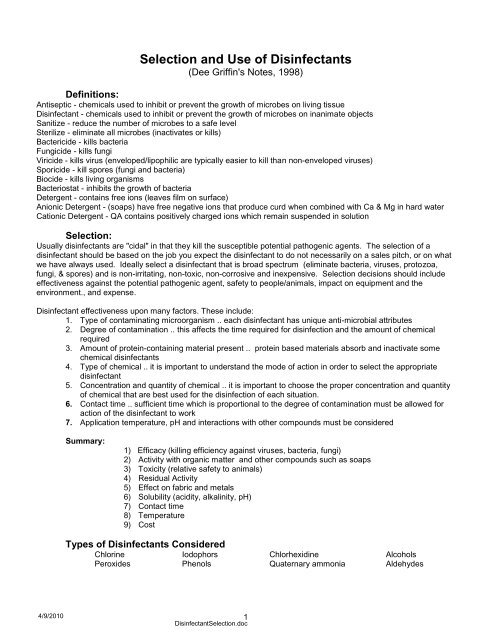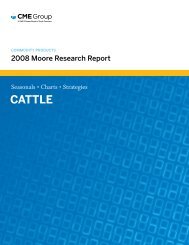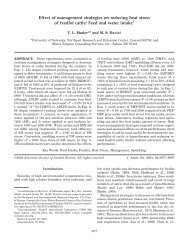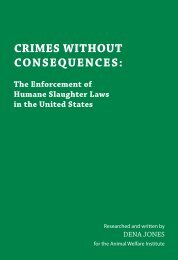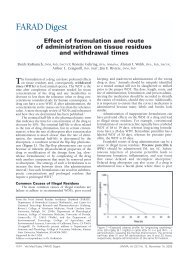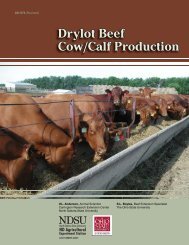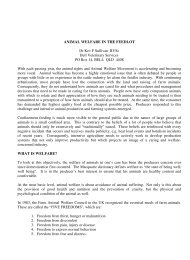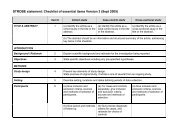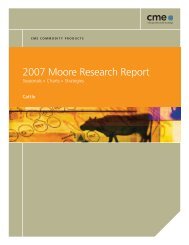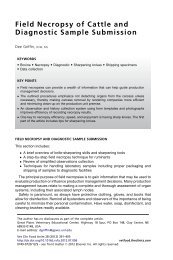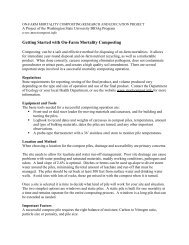Selection and Use of Disinfectants (Dee Griffin's Notes, 1998) - gpvec
Selection and Use of Disinfectants (Dee Griffin's Notes, 1998) - gpvec
Selection and Use of Disinfectants (Dee Griffin's Notes, 1998) - gpvec
Create successful ePaper yourself
Turn your PDF publications into a flip-book with our unique Google optimized e-Paper software.
4/9/2010<br />
<strong>Selection</strong> <strong>and</strong> <strong>Use</strong> <strong>of</strong> <strong>Disinfectants</strong><br />
(<strong>Dee</strong> <strong>Griffin's</strong> <strong>Notes</strong>, <strong>1998</strong>)<br />
Definitions:<br />
Antiseptic - chemicals used to inhibit or prevent the growth <strong>of</strong> microbes on living tissue<br />
Disinfectant - chemicals used to inhibit or prevent the growth <strong>of</strong> microbes on inanimate objects<br />
Sanitize - reduce the number <strong>of</strong> microbes to a safe level<br />
Sterilize - eliminate all microbes (inactivates or kills)<br />
Bactericide - kills bacteria<br />
Fungicide - kills fungi<br />
Viricide - kills virus (enveloped/lipophilic are typically easier to kill than non-enveloped viruses)<br />
Sporicide - kill spores (fungi <strong>and</strong> bacteria)<br />
Biocide - kills living organisms<br />
Bacteriostat - inhibits the growth <strong>of</strong> bacteria<br />
Detergent - contains free ions (leaves film on surface)<br />
Anionic Detergent - (soaps) have free negative ions that produce curd when combined with Ca & Mg in hard water<br />
Cationic Detergent - QA contains positively charged ions which remain suspended in solution<br />
<strong>Selection</strong>:<br />
Usually disinfectants are "cidal" in that they kill the susceptible potential pathogenic agents. The selection <strong>of</strong> a<br />
disinfectant should be based on the job you expect the disinfectant to do not necessarily on a sales pitch, or on what<br />
we have always used. Ideally select a disinfectant that is broad spectrum (eliminate bacteria, viruses, protozoa,<br />
fungi, & spores) <strong>and</strong> is non-irritating, non-toxic, non-corrosive <strong>and</strong> inexpensive. <strong>Selection</strong> decisions should include<br />
effectiveness against the potential pathogenic agent, safety to people/animals, impact on equipment <strong>and</strong> the<br />
environment., <strong>and</strong> expense.<br />
Disinfectant effectiveness upon many factors. These include:<br />
1. Type <strong>of</strong> contaminating microorganism .. each disinfectant has unique anti-microbial attributes<br />
2. Degree <strong>of</strong> contamination .. this affects the time required for disinfection <strong>and</strong> the amount <strong>of</strong> chemical<br />
required<br />
3. Amount <strong>of</strong> protein-containing material present .. protein based materials absorb <strong>and</strong> inactivate some<br />
chemical disinfectants<br />
4. Type <strong>of</strong> chemical .. it is important to underst<strong>and</strong> the mode <strong>of</strong> action in order to select the appropriate<br />
disinfectant<br />
5. Concentration <strong>and</strong> quantity <strong>of</strong> chemical .. it is important to choose the proper concentration <strong>and</strong> quantity<br />
<strong>of</strong> chemical that are best used for the disinfection <strong>of</strong> each situation.<br />
6. Contact time .. sufficient time which is proportional to the degree <strong>of</strong> contamination must be allowed for<br />
action <strong>of</strong> the disinfectant to work<br />
7. Application temperature, pH <strong>and</strong> interactions with other compounds must be considered<br />
Summary:<br />
1) Efficacy (killing efficiency against viruses, bacteria, fungi)<br />
2) Activity with organic matter <strong>and</strong> other compounds such as soaps<br />
3) Toxicity (relative safety to animals)<br />
4) Residual Activity<br />
5) Effect on fabric <strong>and</strong> metals<br />
6) Solubility (acidity, alkalinity, pH)<br />
7) Contact time<br />
8) Temperature<br />
9) Cost<br />
Types <strong>of</strong> <strong>Disinfectants</strong> Considered<br />
Chlorine Iodophors Chlorhexidine Alcohols<br />
Peroxides Phenols Quaternary ammonia Aldehydes<br />
Disinfectant<strong>Selection</strong>.doc<br />
1
Hypochlorites:<br />
Chlorine disinfectants as well as iodine disinfectants belong to the group <strong>of</strong> halogens. Chlorine eliminates both<br />
enveloped <strong>and</strong> non-enveloped viruses. Chlorine is also effective against fungi, bacteria, <strong>and</strong> algae. Chlorine is not<br />
effective against spores. Household bleach ( 5.25% NaClO ), a common source, is cheap <strong>and</strong> readily available. It<br />
is typically diluted using 1:128 to 1:32 with water (1/8 to1/2 cup per gallon <strong>of</strong> water).<br />
Chlorine disinfectants are corrosive to metals <strong>and</strong> cause deterioration <strong>of</strong> fabrics. Chlorine in high concentrations is<br />
irritating to the mucus membranes, eyes, <strong>and</strong> skin. Organic material such as feces inactivate chlorine disinfectants<br />
therefore surfaces must be clean be for using a chlorine disinfectant. In order to obtain maximum results with<br />
chlorine disinfectants they must remain in contact with surfaces for several minutes. The pH <strong>of</strong> the water used for<br />
dilution should be between 6 to 8 to be effective. The effectiveness decreases when application temperatures are<br />
below 65 degrees. Decreasing the temperature to 50 degrees cuts the effectiveness in half. Chlorination <strong>of</strong> drinking<br />
water for cattle should not exceed 6 to10ppm. <strong>Use</strong> the lower value in continuous flow or low volume reservoir<br />
systems.<br />
Summary: 1) Provide wide germicidal activity <strong>and</strong> are relative non-toxic<br />
2) Limited activity when in the presence <strong>of</strong> organic matter<br />
3) Poor residual activity <strong>and</strong> corrosive<br />
4) Fair effectiveness as sporicidal agents<br />
5) Effective at low concentrations for disinfecting clean, small objects<br />
6) Low cost but requires frequent applications<br />
Iodine <strong>and</strong> iodophor disinfectants:<br />
Iodine <strong>and</strong> iodophors are simply chemical compounds. These compounds can be included in a time release<br />
formulation <strong>and</strong> with soaps (surgical scrubs). Simple iodine tinctures (iodine + R-OH) do not contain a cleaning<br />
compound. Iodine <strong>and</strong> iodophors are bactericidal, sporicidal, virucidal <strong>and</strong> fungicidal. Iodine like chlorine is<br />
inactivated in the presence <strong>of</strong> organic material <strong>and</strong> to thoroughly disinfect they must be applied multiple times.<br />
Iodine tinctures can be very irritating to tissues, stain fabric <strong>and</strong> corrosive. "Tamed" iodines such as surgical scrubs<br />
<strong>and</strong> surgical disinfectants are generally not irritating to tissues. Tamed iodines include: Betadyne, Povidone,<br />
Wescodyne, Virac, <strong>and</strong> Prepodyne. Others include: One Step & Iosan.<br />
4/9/2010<br />
Summary: 1) Provide wide germicidal activity <strong>and</strong> are relative non-toxic<br />
2) Limited activity when in the presence <strong>of</strong> organic matter<br />
3) Poor residual activity, corrosive <strong>and</strong> stain fabric <strong>and</strong> equipment<br />
4) Fair effectiveness as sporocidal agents but better than chlorine<br />
5) Effective at low concentrations for disinfecting clean, small objects<br />
6) Low cost but requires frequent applications<br />
Chlorhexidine:<br />
Chlorhexidine, a biguanide, is one the more widely used disinfectants. Chlorhexidine is relatively non-irritation to<br />
tissues. Chlorhexidine, while considered bactericidal, virucidal, & fungicidal, is less effective against these agents<br />
than many other disinfectants. Chlorhexidine maintains effectiveness in the presence <strong>of</strong> some organic material but<br />
cleaning before application is recommended. To be effective chlorhexidine must remain in contact with the surface<br />
for not less than five minutes. Hard or alkaline water will cause precipitation <strong>of</strong> the active ingredients necessary for<br />
disinfection. Chlorhexidine disinfectants include: Nolvasan, Chlorhex, Chlorasan, Virosan, Hibistat, Phisohex<br />
Summary: 1) Wide germicidal activity but ineffective against some important species) & non-toxic<br />
2) Some activity in the presence <strong>of</strong> organic matter<br />
3) Some residual activity but must be in contact for at least five minutes<br />
4) Fair effectiveness as sporicidal agents<br />
5) Effective at low concentrations for disinfecting clean, small objects<br />
6) Low cost but requires frequent applications<br />
Alcohols:<br />
Alcohols are commonly used topical disinfectants. They effective against Gram + <strong>and</strong> Gram - bacteria, fungal<br />
spores, <strong>and</strong> enveloped viruses. Alcohols are not effective against bacterial spores <strong>and</strong> non-enveloped viruses.<br />
Alcohols require time to work <strong>and</strong> they do not penetrate organic material. Alcohol is not only irritating to tissues, the<br />
damage to proteins in open wounds may actually promote bacterial growth. To expensive for general use.<br />
Summary: 1) Wide germicidal activity, non corrosive, poses a fire hazard <strong>and</strong> irritating to tissues<br />
2) Limited activity in the presence <strong>of</strong> organic matter <strong>and</strong> limited residual activity.<br />
3) Not effective against bacterial or fungal spores<br />
4) Excellent when used at 70-95% concentration for disinfecting instruments, etc.<br />
Disinfectant<strong>Selection</strong>.doc<br />
2
Oxidizing Agents:<br />
Peroxides such as hydrogen peroxide are <strong>of</strong>ten used to clean wounds. The activity <strong>of</strong> peroxides is greatest against<br />
anaerobic bacteria. Hydrogen peroxide is not virucidal <strong>and</strong> in some cases are damaging to tissues, resulting in a<br />
prolonged healing time. Hydrogen peroxide is useful for cleaning surgical sites after closure but use sparingly to<br />
avoid penetration <strong>of</strong> suture lines <strong>and</strong> inhibiting healing.<br />
Blended <strong>and</strong>/or stabilized peroxides can be used for disinfection <strong>of</strong> equipment surfaces. Stabilized peroxides may<br />
be blended with iodophors or quaternary ammonia. Some products are effective against a much broader range <strong>of</strong><br />
pathogens including both enveloped <strong>and</strong> non-enveloped viruses, vegetative bacteria, fungi <strong>and</strong> bacterial spores.<br />
Examples include: Hyperox, VirkonS,<br />
4/9/2010<br />
Summary: 1) Moderate to wide germicidal activity, moderately corrosive <strong>and</strong> limited toxicity<br />
2) Rendered ineffective in the presence <strong>of</strong> organic matter<br />
3) Poor to limited residual activity<br />
4) Not effective against bacterial or fungal spores<br />
5) More valuable as a cleansing <strong>and</strong> deodorizing agent <strong>and</strong> are only moderate cost.<br />
Phenolic disinfectants:<br />
Commonly found in mouth washes, scrub soaps <strong>and</strong> surface disinfectants, <strong>and</strong> are the main disinfectant found in<br />
household disinfectants. Phenols are effective against bacteria (especially gram positive bacteria) <strong>and</strong> enveloped<br />
viruses. Phenols are not effective against non-enveloped viruses <strong>and</strong> spores. Enveloped viruses include: BRS,<br />
BVD, Coronavirus, IBR, Leukemia, PI3, Pox, Rabies <strong>and</strong> Stomatitis virus. Non-enveloped viruses include:<br />
Bluetongue, Papilloma, Parvo, Rota virus. Common spore forming bacteria <strong>of</strong> cattle include all the clostridia's (such<br />
as tetanus) <strong>and</strong> bacillus (such as anthrax).<br />
Phenols maintain their activity in the presence <strong>of</strong> organic material therefore are more useful in foot baths <strong>and</strong> areas<br />
which organic material can not be completely removed. Phenolic disinfectants (including cresols <strong>and</strong> pine oil) are<br />
generally safe but prolonged exposure to the skin may cause irritation. Phenolic disinfectants include: O-Syl, Matar,<br />
Septicol, Hexachlorophene, Environ, One-Stroke, Lysovet, Tek-Trol, Lysol, Pantek, Discan, Pine-sol, <strong>and</strong> Staphene.<br />
Summary: 1) Wide germicidal range <strong>and</strong> relatively non-corrosive <strong>and</strong> limited toxicity<br />
2) Very effective in the presence <strong>of</strong> organic matter<br />
3) Poor to limited residual activity<br />
4) Not sporicidal<br />
5) Typically effective as a deodorizer <strong>and</strong> are <strong>of</strong> low to moderate cost.<br />
Quaternary Ammonium Compounds:<br />
Quaternary ammonium (QA) disinfectant contain NH4. The labels <strong>of</strong>ten list a form <strong>of</strong> ammonium chloride (AC) such<br />
as alkyl aryl, benzyl, didecyl, dimethyl, ethylbenzyl, octyl or a combination <strong>of</strong> different AC. Benziconium chloride<br />
(BC) is a more tissue friendly QA than AC. QA disinfectants are effective against Gram + <strong>and</strong> Gram - bacteria, &<br />
enveloped viruses. They are not effective against non-enveloped viruses, fungi, <strong>and</strong> bacterial spores. QA<br />
compounds bind to organic material including soaps so the area to be disinfected clean <strong>and</strong> rinsed <strong>of</strong> soap.<br />
Extremely hard water also deactivates QA disinfectants QA compounds are generally low in toxicity but prolonged<br />
contact can be irritating. QA disinfectants include: Roccal, Quats, Lysoquat, Multi-Quat, TKO, Utmost <strong>and</strong> Zephiran.<br />
Summary: 1) Wide germicidal range, non-corrosive <strong>and</strong> low toxicity<br />
2) Reduced efficiency <strong>and</strong> residual activity in the presence <strong>of</strong> organic matter<br />
3) Not sporicidal, effective against vegetative bacteria, fungi <strong>and</strong> viruses<br />
4) Limited effectiveness in soaps, detergents <strong>and</strong> hard water salts<br />
5) Good disinfectant for use on cleaned surfaces <strong>and</strong> low cost<br />
Aldehydes:<br />
Aldehydes are have a wide germicidal spectrum. Glutaraldehyde are bactericidal, viricidal, fungicidal <strong>and</strong> sporicidal.<br />
They have a moderated residual activity <strong>and</strong> are effective in the presents <strong>of</strong> moderate organic material.<br />
Glutaraldehyde disinfectants include: Lys<strong>of</strong>ume <strong>and</strong> Wavicide-I / Wavicide-06. Formaldehydes are very potent<br />
disinfectants, but can be highly toxic to people <strong>and</strong> animals. <strong>Use</strong> them only as a last resort <strong>and</strong> then under trained<br />
supervision in a well ventilated setting.<br />
Summary: 1) Wide germicidal activity, sporicidal <strong>and</strong> fungicidal, but moderately toxic<br />
2) Slight to moderate efficiency in presence <strong>of</strong> organic matter<br />
3) Slight residual activity<br />
4) Most <strong>of</strong> these products are moderately expensive.<br />
Disinfectant<strong>Selection</strong>.doc<br />
3
Disinfectant <strong>Selection</strong> Table<br />
Compound<br />
Examples<br />
Bactericidal<br />
4/9/2010<br />
Chlorine<br />
0.01-5%<br />
Clorox<br />
Good<br />
Viricidal Very Good<br />
Envelope<br />
Viruses Yes<br />
Non-Envelope<br />
Viruses Yes<br />
Bacterial<br />
Spores Fair<br />
Fungicidal<br />
Effective in<br />
Organic Matter<br />
Inactivated<br />
by soap<br />
Effective in<br />
Hard water<br />
Contact<br />
Time (minutes)<br />
Residual<br />
activity<br />
Good<br />
Poor<br />
No<br />
Yes<br />
5-30<br />
Poor<br />
Iodine<br />
Iodophor<br />
0.5-5%<br />
Tincture /<br />
Provodine<br />
Good<br />
Good<br />
Yes<br />
Yes<br />
Fair<br />
Good<br />
Fair<br />
No &Yes<br />
No<br />
10-30<br />
Poor<br />
Chlorhexidine<br />
0.05-0.5%<br />
Novalsan<br />
Very Good<br />
Very Good<br />
Yes<br />
No<br />
Poor<br />
Fair to Good<br />
Fair<br />
No<br />
Yes<br />
5-10<br />
Good<br />
Disinfectant<strong>Selection</strong>.doc<br />
4<br />
Alcohol<br />
70-95%<br />
Good<br />
Good<br />
Yes<br />
No<br />
Fair<br />
Fair<br />
Fair<br />
No<br />
Yes<br />
10-30<br />
Fair<br />
Oxidizing<br />
0.2-3%<br />
VikronS<br />
Good<br />
Good<br />
Yes<br />
Yes<br />
Fair-Good<br />
Fair<br />
Poor<br />
No<br />
Yes<br />
10-30<br />
Poor<br />
Phenol<br />
0.2-3%<br />
Lysol<br />
Good<br />
Fair<br />
Yes<br />
No<br />
Poor<br />
Good<br />
Good<br />
No<br />
Yes<br />
10-30<br />
Poor<br />
Quaternary<br />
Ammonium<br />
0.1-2%<br />
Roccal-D<br />
Good<br />
Fair<br />
Yes<br />
No<br />
Poor<br />
Fair<br />
Fair<br />
Yes<br />
No<br />
10-30<br />
Fair<br />
Aldehyde<br />
1-2%<br />
Wavicide<br />
Very Good<br />
Very Good<br />
Yes<br />
Yes<br />
Good<br />
Good<br />
Good<br />
No<br />
Yes<br />
10-600<br />
Cattle Viruses With & Without Viral Envelopes<br />
Virus Envelope Virus Envelope Virus Envelope<br />
Bluetongue No Malignant Catarrhal Fever Yes PI3 Yes<br />
Rotavirus No Enteric Coronavirus Yes Rabies Yes<br />
Papillomatosis No Resp Coronavirus Yes Herpes Mammillitis Yes<br />
Leukemia Yes BVD Yes Cowpox Yes<br />
Papular Stomatitis Yes BRSV Yes Pseudocowpox Yes<br />
Vesicular Stomatitis Yes IBR / IPV Yes Lumpy Skin Disease Yes<br />
Note: Foot & Mouth Disease (an Aphthovirus) is a Non-Enveloped RNA virus.<br />
BSE Prion denatured by 5.25% Na Hypochlorite & 275º (F) at 48.5 lbs pressure for 20 minutes.<br />
References:<br />
Bayley, A.J. Compendium <strong>of</strong> Veterinary Products. 1997.<br />
Gardner, J.F. Antiseptics <strong>and</strong> <strong>Disinfectants</strong>. 1993<br />
Hanel, E. Liquid Chemical Germicides. 1989.<br />
Jeffrey, Joan. Sanitation-Disinfection Basics. <strong>1998</strong>.<br />
Kennedy, Jim <strong>and</strong> Joe Bek. Class notes. NCTA <strong>1998</strong>.<br />
McCluggage, Dave. A practical guide to disinfectants. 1991.<br />
Mohanty, S.B. Veterinary Virology. 1981.<br />
Perino, L.J. Personal communication on viral classification, <strong>1998</strong>.<br />
Fair
4/9/2010<br />
DISINFECTANTS <strong>and</strong> ANTISEPTICS<br />
Disinfectant List<br />
Disinfectant<strong>Selection</strong>.doc<br />
5<br />
Active<br />
Ingred<br />
%<br />
Conc<br />
Suppliers<br />
CHLORHEXIDINE DISINFECTANTS<br />
ChlorhexiDerm Disinfectant CHXD 2 .DVM<br />
Chlorhexidine Disinfectant Solution CHXD 2 .AgriLabs<br />
Chlorhexidine Solution CHXD 2 .Butler, Durvet, First Priority, Vedco<br />
Nolvasan -S CHXD 2 .Fort Dodge<br />
Nolvasan Solution CHXD 2 .Fort Dodge<br />
FORMALDEHYDE DISINFECTANTS FMDH<br />
Formaldehyde Solution 37% FMDH 37 .Butler<br />
Vinco Formaldegen FMDH 91 .Vinel<strong>and</strong><br />
Vinco Formaldehyde Solution FMDH 37 .Vinel<strong>and</strong><br />
Vinco Sani-Squad FMDH 27 .Vinel<strong>and</strong><br />
IODINE COMPLEX DISINFECTANTS<br />
Bactrol IODN ? .AgriLabs<br />
Dineotex IODN 18 .Stearns<br />
Gentle Iodine Wound Spray IODN 3 .First Priority<br />
Interdyne IODN 2 .Intercon<br />
Iodine Tincture 7% IODN 7 .First Priority<br />
I<strong>of</strong>ec -20 Disinfectant IODN 2 .Lovel<strong>and</strong><br />
Iosan IODN 2 .WestAgro<br />
Magna Din-15 IODN 2 .Magna<br />
Metz Iodine Detergent IODN 18 .Metz<br />
One Step IODN 2 .Chem-Tronics, Vedco<br />
Povidine Solution IODN 1 .Butler, First Priority<br />
PVP Iodine IODN 10 .Western Chemical<br />
R.I.D. Russell Iodine Disinfectant IODN 2 .Russell<br />
Rocadyne IODN 18 .Rochester Midl<strong>and</strong><br />
Sungro Dairy & Livestock Disinfectant IODN 2 .Sungro<br />
VPL Xenodine, Spray IODN 1 .V.P.L.<br />
West-Vet Premise Disinfectant IODN 18 .WestAgro<br />
ALCOHOL DISINFECTANTS<br />
Blue Lotion Topical Antiseptic (+BC-0.5) ROH 13 .First Priority<br />
Cavicide (DBAC 2) ROH 19 .Metrex<br />
DC&R Disinfectant ( + formaldehyde) ROH 19+2 .Lovel<strong>and</strong><br />
Isopropyl Alcohol 70% ROH 70 .Chem-Tronics, First Priority, RXV, Vedco<br />
Isopropyl Alcohol 99% ROH 99 .AgriPharm, Chem-T, FP,RXV,Vedco<br />
Kleen-Aseptic (+DBAC-0.3) ROH 14 .Metrex<br />
Medicide (POL-0.3) ROH 52 .Hysan<br />
Microban X-580 BLEND 25 .Microban<br />
PHENOLIC DISINFECTANTS<br />
25-Pines POIL .Stearns<br />
Beaucoup PHOL 9 .Ecolab
Big Pine (includes a QA) POIL ? .Intercon<br />
Discan -256 PHOL 18 .Lovel<strong>and</strong><br />
FPD 256 PHOL 22 .AgriLabs<br />
Lysol I.C. Disinfectant, Spray, & Presoak PHOL 15 .R & C ProBr<strong>and</strong>s<br />
Magna CP-1 (+cresol-31) PHOL 24 .Magna<br />
Magna Phen-100 PHOL 29 .Magna<br />
Magna Clean CRSOL .Magna<br />
Matar PHOL 18 .Ecolab<br />
Pantek Cleanser PHOL 50 .Lovel<strong>and</strong><br />
Pine-Sol POIL 18<br />
Tek-Trol PHOL 26 .AgriLabs, Bio-Tek<br />
Tri-Phenol-R/256 PHOL 21 .Russell<br />
VPL SynPhenol-3 PHOL 26 .V.P.L.<br />
QUATERNARY AMMONIUM DISINFECT..<br />
(MOST CONTAIN DBAC, DDAC, &/OR DEAC)<br />
Airx 44 Plus <strong>and</strong> Airx 78 Plus D-AC 4-7 .Chemifax)<br />
Ascend D-AC 15 .Ecolab<br />
Bacto-Sep D-AC 7.5 .Interchem<br />
Benzalkonium Chloride 50% BC 50 .Argent<br />
CarraVet Antiseptic Wound Cleanser BC ? .V.P.L.<br />
CAS-5 D-AC 8 .Magna<br />
Cide-All D-AC 4 .Chemifax<br />
D-128 <strong>and</strong> D-256 D-AC 7/15 .Vedco<br />
Dakil D-AC 12 .Davis<br />
Di-Quat 10-S D-AC 10 .Butler<br />
Disintegrator D-AC 15 .Phoenix<br />
F-48 D-AC 8 .Rochester Midl<strong>and</strong><br />
FSD-4 D-AC 3 .DuBois<br />
GermKill 256 D-AC 15 .Lovel<strong>and</strong><br />
Hi-Tor Plus D-AC 15 .Ecolab<br />
KennelSol QA ? .Alpha Tech Pet<br />
LDC-19 D-AC 2 .Intercon<br />
Lifegard 256 Plus D-AC 15 .Rochester Midl<strong>and</strong><br />
Lysol I.C. Quaternary Cleanr/Disinfect.. QA ? .R & C ProBr<strong>and</strong>s<br />
Magna Non-Chlorinated Foam Hatch AAAC ? .Magna<br />
Magna Q-20, Q-25 <strong>and</strong> Q-43 D-AC 10-22 .Magna<br />
Magna Q-Detergent QA ? .Magna<br />
Marcicide II D-AC 2 .M.A.R.C.<br />
Mint Disinfectant QA ? .Air-Tite<br />
Multi-Purpose Disinfectant D-AC ? .LeGear<br />
Multi-Quat 128 D-AC 7.6 .Intercon<br />
Neu-Quat 64 D-AC 3.8 .Hysan<br />
P-128 QA .First Priority<br />
Parvo Plus 4X D-AC 15 .Butler<br />
Parvosol D-AC 4.8 .KenVet<br />
Purina Annihilator CD D-AC 15 .Purina Mills<br />
Purina Disinfectant <strong>and</strong> Concentrate 4x D-AC 6/23 .Purina Mills<br />
Q-128 D-AC 7.6 .Chem-Tronics<br />
Q-Cide D-AC 7.6 .Ecolab<br />
QD-4 D-AC 5.6 .DuBois<br />
4/9/2010<br />
Disinfectant<strong>Selection</strong>.doc<br />
6
Quanto D-AC 7.6 .Ecolab<br />
Quatamine D-AC 10 .Stearns<br />
Quat-A-Mone D-AC 20 .Russell<br />
Roccal -D & Roccal-D Plus D-AC 20 .Pharmacia & Upjohn<br />
Russell/Dual Chain D-AC 20 .Russell<br />
Steramine Disinfectant D-AC 10 .Stearns<br />
Sunkleen 45 <strong>and</strong> Sunkleen 90 D-AC 4.5/9 .Sungro<br />
Tetra San II D-AC 10 .Alex C. Fergusson<br />
T K O Detergent Sanitizer D-AC 4.5 .Uncle Sam<br />
Tor II D-AC 3 .Ecolab<br />
Tryad D-AC 5 .Lovel<strong>and</strong><br />
Utmost 256 D-AC 15 .RXV<br />
Veterinarian Disinfectant D-AC 9 .Pettec<br />
Vigilquat D-AC 4 .Alex C. Fergusson<br />
VPL Parvo-Cide 2 D-AC 4.6 .V.P.L.<br />
V.T.D. D-AC 4.5 .Interchem<br />
GLUTARALDEHYDE DISINFECTANTS<br />
Aldacide 200 GDH 20 .Russell<br />
Lys<strong>of</strong>ume GDH<br />
Wavicide GDH<br />
CHLORINE DISINFECTANTS<br />
Hypo-Chlor Formula 6.40 NACLO 6.4 .Stearns<br />
Lifegard 830F NACLO ? .Rochester Midl<strong>and</strong><br />
Lifegard CIP-Plus & HD P+NACLO ? .Rochester Midl<strong>and</strong><br />
OXIDIZING DISINFECTANTS<br />
Hydrogen Peroxide 3% Solution OXIDZ 3 .First Priority<br />
Lifegard 800 OXIDZ ? .Rochester Midl<strong>and</strong><br />
Lifegard 820 OXIDZ ? .Rochester Midl<strong>and</strong><br />
Lifegard 888F OXIDZ ? .Rochester Midl<strong>and</strong><br />
Lifegard CIP-HD OXIDZ ? .Rochester Midl<strong>and</strong><br />
Lifegard Cleen Sheen OXIDZ ? .Rochester Midl<strong>and</strong><br />
Virkon S OXIDZ 20 .Durvet<br />
OTHER DISINFECTANTS<br />
Lifegard 7000 PO4A .Rochester Midl<strong>and</strong><br />
Lifegard 7500F PO4A .Rochester Midl<strong>and</strong><br />
Lifegard 7700 PO4A .Rochester Midl<strong>and</strong><br />
Super Clean-R 500 NMSIL .Russell<br />
Vinco Potassium Permanganate KPM .Vinel<strong>and</strong><br />
Clinafarm EC IMTZ .Schering Plough<br />
Lifegard Plasti-Safe SALT .Rochester Midl<strong>and</strong><br />
Lifegard 7300 CITA .Rochester Midl<strong>and</strong><br />
Magna P-Detergent SOAP .Magna<br />
4/9/2010<br />
Disinfectant<strong>Selection</strong>.doc<br />
7


